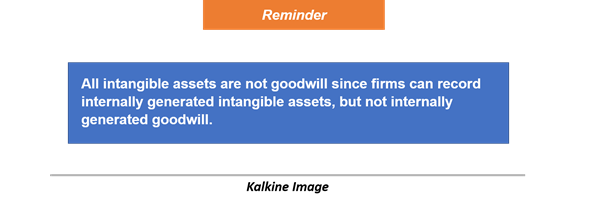What is Goodwill?
Goodwill is an intangible asset, which is recognised in the balance sheet after a business merger or acquisition/takeover. As an intangible asset, it does not have form and is expected to benefit business for more than one year.
Goodwill treatment and associated international accounting standards have been in debate. There are chances that the International Financial Reporting Standards (IFRS) related to goodwill could be altered over the near-term.
International Accounting Standards Board (IASB) is conducting discussions on IFRS 3 Business Combinations and suggestion are open until the end of 2020. Goodwill essentially reflects the non-monetary assets of the business.
An internally generated intangible asset is not recorded in the books of accounts until it satisfies certain conditions like measurement of costs, feasibility, ability to sale or use, and potential future benefits are viable.
Likewise, a firm cannot measure the value of its internally generated attributes like brand loyalty or brand reputation, therefore such potential benefits for firm are not recognised in the balance sheet because they are non-quantifiable. Thus, internally generated goodwill does not find a place in books of accounts.
Some intangible assets can be measured, recorded in the balance sheet such as cost of an export license, cost of the overseas trading license, cost incurred in developing proprietary technology. In addition to measurement, the asset should yield future benefits to the firm.
A firm that has not ever engaged in a business combination may not have goodwill on the balance sheet since internally generated goodwill is not recorded in the books.

Goodwill is the premium paid over the fair value of net assets at the time of acquisition and is recorded in the balance sheet after a business combination. Internally generated intangible assets are measurable, saleable and have the propensity to generate future benefits.
Intangible assets are amortised over the useful life of asset and expenses are incurred on the income statement, and value of the asset is lowered on the balance sheet. Whereas goodwill can last as long as the business is operating, therefore a downgrade in the value of goodwill is incurred as an impairment expense.
Impairment testing of goodwill
IFRS necessitates firms to test goodwill for impairments every year. Earlier standards required to amortise over a period of time, which was replaced with annual impairment testing. Firms pay a premium over the fair value of net assets, and the premium is carried on the balance sheet.
As combined entity embarks on trading in subsequent years after a business combination, there can be circumstances where the book value of goodwill may not reflect the adequate value. Impairment testing enables understanding whether the recorded goodwill is reflective of true potential benefits or otherwise.
Under impairment testing, the book value of goodwill is compared to future benefits or revenue-generating ability. Alternatively, the carrying value of goodwill is compared to the recoverable amount, which is fair value less cost of disposal.
In case when the recoverable amount is less than carrying value of goodwill, the firm will be required to incur impairment loss. But testing an individual asset is not viable, especially when it does not yield benefits individually and is used with other assets to generate future benefits.
Now cash-generating units (CGUs) come into play when a group of assets is yielding future benefits for the firm. A CGU is a small number of identifiable assets capable of generating cash inflows as a group.
Firms undertake impairment testing for the CGUs in the balance sheet. It is much more like a business valuation test. A potential impairment is charged to the assets constituting a cash-generating unit, should the carrying value be greater than the recoverable amount.
At the outset, firms are required to compare the carrying value of goodwill, which includes CGUs, against the recoverable amount. A cash-generating unit in a company could be one of many divisions of the firm, likewise, a firm can have multiple CGUs, depending on the acquired assets.
At the time of the acquisition, firms may assign goodwill to specific CGUs depending on the expected benefits. For impairment testing of CGUs, the carrying value of CGU along with assigned goodwill is compared to the recoverable amount.
Similarly, an impairment loss is recognised when the carrying value of an asset is greater than the recoverable amount. First, the impairment loss is charged to assigned goodwill on the CGU during acquisition, and the leftover is allocated proportionately to assets within the CGU.
Limitations of goodwill
Goodwill is a volatile intangible asset, and the carrying value of CGUs can incur write-downs or impairment losses as business environment of a firm worsens, and anticipated benefits appear overstated, therefore altering the expected benefits through impairment losses.
A firm executing inorganic growth strategy through business combinations can have a large amount of goodwill on the books, especially when acquisition target has low net assets but is commanding a high premium.
A higher premium over the fair value of net assets means a higher level of goodwill as well, and the firm needs to justify higher goodwill by generating expected benefits through synergies of combined business entity.
Should the expected benefits from a transaction turn otherwise, the impairment loss as a result can be labelled as writing-off the premium paid upon business combination over the fair value of net assets.
As asset-light businesses have grown increasingly, the premium paid over the fair value of net assets is sometimes quite huge. As a result, the combined entity may have a higher level of net assets to goodwill ratio.
Increasingly, the annual impairment testing undertaken by the firms is becoming a source of concern given that it takes considerable time, assumptions in an uncertain business environment, efforts and knowledge.
It is the reason why IASB is conducting a discussion on IFRS 3 Business Combinations, and the outcome would be available over the near term. Return to amortisation of goodwill could lower the fluctuations in corporate profits.
 Please wait processing your request...
Please wait processing your request...